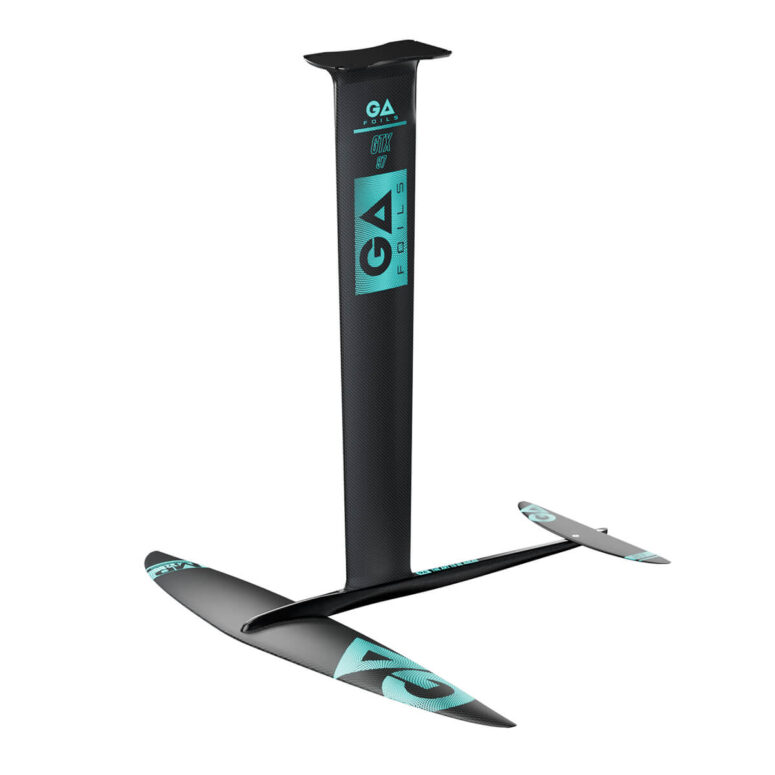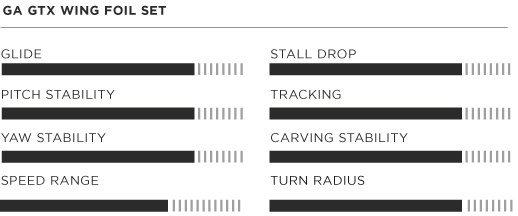

When you purchase gear through links on our site, we may earn a small commission. Here’s why you can trust our tests and our affiliate partner.

Dutch brand Gaastra originally started up as a Victorian sailmaker at the turn of the 19th century but are most famous recently for being one of the enduring windsurf brands founded in 1980. This timeframe is probably longer than half our readership have been alive. They were onboard with windfoiling early doors, and it’s a natural progression for a brand with such a rich heritage to aim some products specifically for the wingfoil market, and we were presented with the GA Foils sub brand which contains all their wing-related offerings.
On test is the GTX Wing Foil set, which bases itself around an extremely stiff tapered, full carbon mast sitting at 97cm long (sidenote: we have it on good authority that there’s an 85cm version coming soon too). The whole package arrives with neat, tailored EVA covers for each component, and a decent sized carry bag with a leaf system internally to pad out in between items. All fixings are M6 on the system and accept a T30 Torx driver.
The mast’s top section and base plate connection is absolutely solid with a generous amount of carbon. It’s an open toe design for ease of fitting, and the foil box fixings includes some neat bespoke washers which locate themselves with a small indent; they are also reversible to allow for more extreme track positions. The mast tapers down gently both in chord and profile to a slimmer recessed head joint at the fuselage, which attaches firmly with three M6 Torx bolts. Torsional-wise we were extremely impressed with the stiffness of the system, and our rudimentary ‘in-garage’ deflection tests translated to a zero delay feeling when on the water, even when over a larger span of mast of nearly a meter.
The fuselage is a relatively slimline CNC-milled aluminum affair, accepting three more M6 bolts for the front wing and they sit in line and do an ample job of locking on the front wing with little movement. The nose of the fuselage sits on top of the wing rather than being recessed into it, but it’s a fairly hydrodynamically clean iteration of this popular design across the industry. Two small locating points match two holes in the front wing to maintain perfect alignment, which is an intelligent touch.
We were supplied with two MP (Maximum Performance) front wings in 1490 and 1090 which would form a sensible quiver for an 80kg intermediate rider and above. These have a traditional delta outline and generous taper into the tips, hinting immediately at eager roll characteristics, which it certainly achieves. There’s a light concave in the trailing edge of the foil profile in the middle of the wing which fades gently out to the wingtips, which have a hint of downturn. The nose of both front wings has a pronounced point to it rather than a radius, making for a purposeful looking profile.
In the water, we found this system aligns itself well with more progressive mid to high-aspect platforms. The mast feels very solid, and its taper means it’s quick when riding high. 97cm is quite a long mast, and allowed for some decent upwind angles as well as plenty of margin for error when dropping into a bumpy wave face.
The MP1490 has an impressive low end, and the speed range continues up to quite a decent pace. We utilized this for some lighter wind sessions and were impressed with the comfortable speed range and glide characteristics. The MP1090 is a significantly more performant beast, requiring more positive wind conditions to get going; once up, it sits in its speed range comfortably and provides some excellent glide. Roll-wise, it sits in the magic span region of around 90cm with those tapered tips easing its rail-to-rail transition.
The 62cm fuse we were supplied with made for an entertaining ride but still maintained decent pitch stability throughout the speed range; we thought the more performant foil matches this fuse size well, but the 72cm could certainly be employed for a more timid rider getting to grips with the system, or to make the pump cadence a more mellow affair.
The 210 is the smallest and most performant stabilizer offering from GA; it’s completely flat in the tips, running top mounted on the fuse. It feels quite rapid and loose when required, and comes with various shim options which we had a play with, and we found a single +1 degree shim seemed to spice up the turning, without increasing front foot pressure drastically. The foil preferred to run more or less central on our foil box, where other more progressive high-aspect systems would sit right at the front so trimming it across board brands should be simple.
The GTX foil system seems unashamedly aimed at wind-propelled foil sports and provides a surprising amount of performance and high-end carbon in an unassuming package. It’s going to suit anyone from intermediates perfecting their gybes to far more advanced riders. The solid nature and stiffness of the system balances speed, maneuverability and glide well, resulting in an easy-to-access and performant system.
